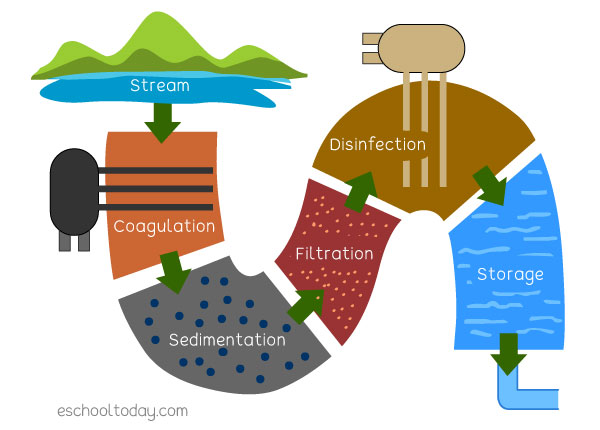See This Report on Residential Water Treatment System
Table of ContentsSome Known Facts About Residential Water Treatment System.A Biased View of Residential Water Treatment SystemSee This Report about Residential Water Treatment SystemResidential Water Treatment System Things To Know Before You Buy
1 The requirement for massive water treatment, Water treatment is the process of eliminating all those materials, whether organic, chemical or physical, that are potentially hazardous in water supply for human as well as residential usage. Water also requires to be non-corrosive, suggesting it will certainly not create damages to pipework.This develops a demand for big quantities of secure water to be provided accurately as well as constantly, and this demand is growing. As metropolitan populations boost, there is a demand to find brand-new resources to fulfill the growing demand. If groundwater is readily available this can commonly be used with very little therapy yet any kind of surface area water resource will certainly need to be treated to make it risk-free.
6 clarifies just how this calculation is made yet first you will certainly take a look at the primary stages in the water treatment procedure. 5. 2 Stages in large-scale water treatment, There are frequently 7 actions (Figure 5. 2) in large water treatment for urban metropolitan water system (Abayneh, 2004). Each of the actions will certainly be described in turn in this section.

The Facts About Residential Water Treatment System Uncovered
Below the water is gently mixed by paddles in a flocculation basin (Number 5. 5) as well as the flocs come into call with each various other to develop larger flocs. The flocculation container usually has a number of areas with reducing mixing speeds as the water advances through the container (Figure 5.
6(b)) for several hours for sedimentation to occur. The product gathered at the base of the container is called sludge; this is gotten rid of for disposal. 5.2. 5 Filtering, Filtration is the procedure where solids are divided from a liquid. In water therapy, the solids that are not divided out in the sedimentation tank are removed by passing the water with beds of sand as well as crushed rock.
7), with a flow price of 48 cubic metres per square metre of filter surface per hour (this is composed as 48 m3 m2 h1) are usually made use of. When the filters have lots of trapped solids, they are backwashed. In this process, tidy water and air are pumped in reverse up the filter to remove the trapped pollutants, as well as the water carrying the dirt (described great site as backwash) is pumped right into the sewage system, if there is one.
6 Chlorination, After sedimentation, the water is decontaminated to remove any kind of continuing to be pathogenic micro-organisms. The most frequently utilized disinfectant (the chemical used for disinfection) is chlorine, in the type of a fluid (such as salt hypochlorite, Na, OCl) or a gas.
Getting My Residential Water Treatment System To Work
The amount of chlorine left hereafter is called residual chlorine. This remains in the water completely with the distribution system, shielding it from any micro-organisms that could enter it, till the water gets to the customers. Globe Wellness Company Standards (WHO, 2003) suggest an optimum residual chlorine of 5 mg l1 of water.

7 Additional treatment, Auxiliary treatment might occasionally be required for the benefit of the population. One such circumstances is the fluoridation of water, where fluoride is contributed to water. It has actually been specified by the World Health Organization that 'fluoridation of water products, where possible, is one of the most effective public health and wellness step for the prevention of oral decay' (WHO, 2001).

Residential Water Treatment System Fundamentals Explained
5 mg l1. What does excess fluoride in the water bring about? As mentioned in Study Session 2, in youngsters it can trigger mottling of teeth as well as long term direct exposure can create skeletal fluorosis and also crippling. In such high-fluoride locations, elimination find or decrease of fluoride (called defluoridation) is crucial. The easiest way of doing this is to blend the high-fluoride water with water that has no (or really little) fluoride to make sure that the final mixture is secure - residential water treatment system.
The two chemicals are added to and also swiftly combined with the fluoride-contaminated water and afterwards the water is mixed delicately. Flocs of aluminium hydroxide form as well as these get rid of the fluoride by adsorption and ion exchange. The flocs are after that removed by sedimentation. 5.3 Monitoring of wastes from water therapy plants, From the water therapy process that you have simply examined, make a listing of the different wastes that arise.
In the latter it is included in the inbound sewer, where it can aid negotiation of solids. The backwash from the sand filter is discharged right into the sewage system or gone back to the river after negotiation of solids. Product packaging waste such as chemical drums can be returned to the supplier for reuse.
5.4 Sustainability and strength in water treatment, In Research study Session 4 you review some factors that can influence the sustainability of a water source. As an example, minimizing soil erosion by planting trees and also preserving vegetation can reduce the quantity of silt that accumulates in a reservoir and lengthen its life.